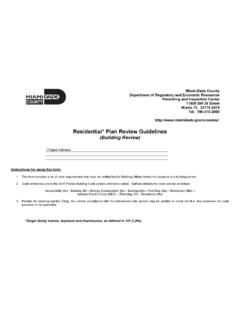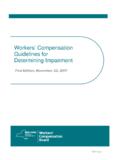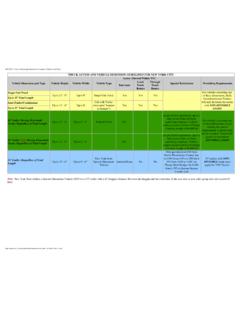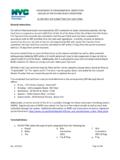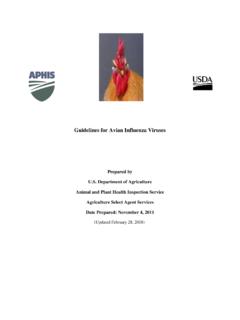Transcription of Stream Crossing Guidelines - Connecticut
1 Inland Fisheries Division Habitat Conservation and Enhancement Program Stream Crossing Guidelines February 26, 2008 DDEEPP IInnllaanndd FFiisshheerriieess DDiivviissiioonn HHaabbiittaatt CCoonnsseerrvvaattiioonn aanndd EEnnhhaanncceemmeenntt PPrrooggrraamm 2 I. INTRODUCTION Inland Fisheries Division (IFD) Habitat Conservation and Enhancement (HCE) staff have been assessing fish passage and instream habitat needs at Stream crossings across Connecticut since the late 1980 s. The program was created in part to ensure that fish and other aquatic life as well as aquatic habitat needs would be effectively addressed during municipal, State and Federal regulatory permit review processes.
2 These Stream Crossing Guidelines are intended to provide government agencies, non-profit environmental groups and private landowners with the best technical guidance available to ensure unimpeded fish passage for resident and anadromous fishes and to minimize construction related impacts. Guidelines focus primarily on fish and fish passage, but incorporating the suggested practices will also benefit other wildlife. This document is not intended to be a technical design manual. Readers should consult specific guidance documents provided by municipal, State, or Federal regulatory offices having permitting authority over a Stream Crossing project. Also, scientific and technical manuals produced by other agencies, including those of the States of Vermont (VDFW 2005), Washington (WDFW 2003), Oregon (Robison et.)
3 Al. 1999) and California (CFGD 2003) can provide additional guidance on fish passage design and related issues. Figure 1. Example of small Stream in Connecticut that supports a fish community. Along a Stream continuum, Stream flow, hydrology, physical habitat and water quality are factors that determine which fish species are present in a watershed and the abundance and diversity of those species. While Connecticut citizens may readily recognize the negative effects of existing dams on fish passage, many may not be aware that Stream crossings, particularly culverts, can permanently block or seasonally impede upstream fish passage. Fish passage needs are often unrecognized on small watercourses.
4 Small streams account for most of the total Stream miles within any watershed (Jackson 2003) with an estimated 70% of Stream channel in the United States being comprised of small, headwater streams (Leopold et al. 1964). Many small streams in Connecticut support fish populations, often times a single DDEEPP IInnllaanndd FFiisshheerriieess DDiivviissiioonn HHaabbiittaatt CCoonnsseerrvvaattiioonn aanndd EEnnhhaanncceemmeenntt PPrrooggrraamm 3 species such as native brook trout (Figure 1). Many problem or impassable Stream crossings were installed before environmental regulations were in place to review Stream Crossing designs and before there was a full understanding of the negative impacts to fish passage.
5 Consequently, fish populations can become fragmented and unable to reach critical spawning, nursery, feeding, or seasonal refuge habitats that are important to the completion of various life history phases. The fragmentation of Stream habitat and fish populations can adversely impact fish community diversity, fish population levels and fish survival. The following section describes common steam Crossing problems observed in Connecticut . II. COMMON Stream Crossing PROBLEMS Perched Culverts The most common Stream Crossing problems in Connecticut are perched culverts that are situated above the elevation of the Stream bottom at the culvert outlet (downstream end) that present obvious physical barriers to upstream fish passage (Figure 2).
6 Perched culvert conditions are the result of improper installation or are created over time by years of excessive scour and erosion of the streambed at the culvert outlet. Freeze-thaw conditions can also lead to culvert perching. Figure 2. Example of culverts perched above streambed. Shallow Water Depth Another common problem are culverts that create shallow water or sheetflow conditions, especially during seasonal low flow periods (Figure 3). Thus, fish cannot swim through these structures due to insufficient water depths. Excessive Water Velocity Excessive water velocities can occur within the main body of a culvert at the inlet/outlet sections. Velocity problems are typically observed within smooth bottom concrete box culverts that do not contain natural streambed substrates and lack channel roughness.
7 Excessive velocities or hydraulic jumps can sometimes occur in culverts placed at improper slopes. Many fish species may not be able to pass through culverts with excessive velocities due to exhaustion (Figure 4). DDEEPP IInnllaanndd FFiisshheerriieess DDiivviissiioonn HHaabbiittaatt CCoonnsseerrvvaattiioonn aanndd EEnnhhaanncceemmeenntt PPrrooggrraamm 4 Figure 3. Example of shallow water conditions in a concrete box culvert. Debris accumulation Debris accumulation is another condition that can block fish passage. Accumulation of debris most often occurs at undersized culvert or multiple culvert situations, usually at the culvert inlet (Figure 5). Debris blockage can cause damage to the Crossing structure or possibly lead to flooding.
8 If debris forms a logjam comprised of large woody debris (LWD), which is defined by biologists as logs with a minimum diameter of 4 inches and a minimum length of 6 feet, it may be possible to remove the logjam and re-introduce portions of LWD downstream of the roadway Crossing where it does not present any hazard. Refer to Inland Fisheries Division management Guidelines within the LWD Factsheet that can be obtained at the DEP website, Figure 4. Example of excessive water velocities resulting in a barrier to fish passage. Velocity barrier DDEEPP IInnllaanndd FFiisshheerriieess DDiivviissiioonn HHaabbiittaatt CCoonnsseerrvvaattiioonn aanndd EEnnhhaanncceemmeenntt PPrrooggrraamm 5 Figure 5.
9 Debris blockage at culvert inlets that blocks fish passage. III. Stream Crossing Guidelines Fish species in Connecticut streams vary greatly in size, and many adult fishes, , blacknose dace, longnose dace and tessellated darter never exceed 4 inches in length. Thus, when designing fish passage at road crossings, consideration must be given to the entire fish community, not just the larger Stream fish such as trout and white sucker. Many of the standards in these Guidelines have been adopted from and are consistent with Army Corps of Engineers Connecticut Programmatic General Permit guidance. Refer to for more details relative to general permit requirements and also contact the DEP Inland Water Resources Division for permit guidance.
10 Figure 6. Clear span bridges and bottomless arch culverts are preferred Stream Crossing structures. DDEEPP IInnllaanndd FFiisshheerriieess DDiivviissiioonn HHaabbiittaatt CCoonnsseerrvvaattiioonn aanndd EEnnhhaanncceemmeenntt PPrrooggrraamm 6 For new or replacement Stream Crossing projects, the Inland Fisheries Division (IFD) typically recommends the installation of clear span bridges or bottomless arch culverts for the Crossing of perennial watercourses (Figure 6). These structures are fish passage friendly since they do not create barriers or impediments to fish migration and they best preserve physical instream habitats. Intermittent watercourses are evaluated for fish passage needs based upon the potential for seasonal utilization of the watercourses by fish.











